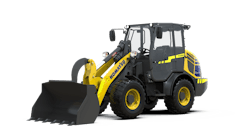Moog Inc. recently partnered with construction and mining machinery OEM Komatsu on the development of a fully electric compact wheel loader.
Electrification of the wheel loader is possible through the use of Moog’s intelligent machine electrification system which contains many of the electronic components necessary for full-electric operation.
For this project, the companies worked closely together said David Grabau, Key Account Manager at Moog Construction, a division of Moog Inc., in an interview with Power & Motion. “Our goal working with Komatsu is to de-risk their development journey,” he said. “We have a very close relationship with our customers and take a system approach. We know that all of our subcomponents work together as a complete system and that allows us to quickly enable a fully electric vehicle.”
He said Moog strives to become an extension of its customers’ engineering and development teams. This benefitted the overall design as well as the ability to quickly modify Komatsu’s wheel loader to accommodate the batteries and electric actuators required for full-electric operation.
Also aiding the speed of development is the fact Moog provides a full system which is designed to the latest standards of safety interlocks between the components. “Therefore, each component is verifying its interconnectivity and allows for quick and safe integration in the field,” said Grabau.
Electronics Replace Hydraulics
To enable full-electric operation of the Komatsu wheel loader, Moog provided the following components as part of its intelligent machine electrification system:
- electric traction motor,
- electric cylinders for lift, tilt and steering,
- all power electronics,
- system controller computer, also called the ECVM, and
- battery and battery management system (BMS).
According to Grabau, the ECVM is the brains of the system. It contains all system communications, including IoT (Internet of Things) modems as well as power distribution. The latter distributes the bus voltage power from the battery to the rest of the components in the system.
What helps make the wheel loader fully electric is the fact there are no hydraulics on it. Similar to the Doosan Bobcat T7X electric compact track loader—which Moog helped develop and was introduced in early 2022—the Komatsu machine only contains a small volume of eco-friendly coolant said Grabau.
WATCH our interview with Moog to learn more about the design of the Doosan Bobcat T7X.
In place of hydraulic components are high-torque servo motors for both traction and driving of the ball screws on each of the axes. In the case of the Komatsu machine, the traditional hydrostatic transmission that would normally be found on a wheel loader of this size was removed said Grabau. The servo motor used for traction is used instead to provide smooth forward and reverse operation as well as regenerative braking.
Benefits of Going All Electric
Moog’s intelligent machine electrification system enables a high level of efficiency and controllability, said Grabau. “That allows you to get more runtime or a reduced battery pack size,” he said. “And the higher level of controllability enables future advanced user controls or full autonomy. So, it's basically autonomous ready.”
This capability is achieved through the type of actuation used in the machine and being able to close the loop to have a more controllable actuator than a traditional hydraulic ram, he explained. Similarly with the wheel loader’s traction drive, control of its forward and reverse motion can be done more accurately.
In terms of efficiency, the all-electric system is in the upper 80% range said Grabau whereas the efficiency of a diesel-hydraulic system is typically 30-40%. Traditional hydraulic systems may also have significant losses in the 40-60% range but an electric alternative is under 20%.
Improving efficiency benefits end-use customers’ total cost of ownership which is vital for construction and other applications in which the wheel loader would be used. This piece of equipment is used for business purposes in most cases and being able to lower operational expenses can be very beneficial to a customer.
Showing this capability can also help the uptake of electric-powered machines – that they’re more than just a trend but can also provide actual performance benefits. This is a key goal for Moog and Komatsu who will be conducting joint testing of the wheel loader.
“Moog is working closely with Komatsu to understand the machine capabilities and performance,” said Grabau. “And the goal is to meet or exceed the diesel-hydraulic equivalent of the machine.”
Komatsu is showing the electric wheel loader during bauma 2022, one of the largest trade shows for the construction and mining industries. Moog is exhibiting at the show as well, highlighting its intelligent machine platform on several electric and autonomous demonstration vehicles.
READ MORE about bauma and the technologies on display at the 2022 event:
bauma 2022: A Turning Point for Electrification in Heavy Equipment
bauma 2022 to Highlight Key Technology Trends for Construction and Mining Equipment




